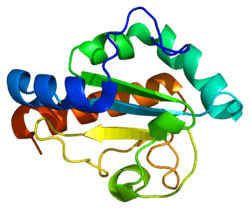TXNDC12
Thioredoxin domain-containing protein 12 is a protein that in humans is encoded by the TXNDC12 gene.[1][2][3]
TXNDC12 belongs to the thioredoxin superfamily (see TXN; MIM 187700). Members of this superfamily possess a thioredoxin fold with a consensus active-site sequence (CxxC) and have roles in redox regulation, defense against oxidative stress, refolding of disulfide-containing proteins, and regulation of transcription factors (Liu et al., 2003).[supplied by OMIM][3]
References
- ↑ Andersson B, Wentland MA, Ricafrente JY, Liu W, Gibbs RA (Jun 1996). "A "double adaptor" method for improved shotgun library construction". Anal Biochem 236 (1): 107–13. doi:10.1006/abio.1996.0138. PMID 8619474.
- ↑ Yu W, Andersson B, Worley KC, Muzny DM, Ding Y, Liu W, Ricafrente JY, Wentland MA, Lennon G, Gibbs RA (Jun 1997). "Large-scale concatenation cDNA sequencing". Genome Res 7 (4): 353–8. doi:10.1101/gr.7.4.353. PMC 139146. PMID 9110174.
- ↑ 3.0 3.1 "Entrez Gene: TXNDC12 thioredoxin domain containing 12 (endoplasmic reticulum)".
Further reading
- Strausberg RL, Feingold EA, Grouse LH et al. (2003). "Generation and initial analysis of more than 15,000 full-length human and mouse cDNA sequences.". Proc. Natl. Acad. Sci. U.S.A. 99 (26): 16899–903. doi:10.1073/pnas.242603899. PMC 139241. PMID 12477932.
- Alanen HI, Williamson RA, Howard MJ et al. (2003). "Functional characterization of ERp18, a new endoplasmic reticulum-located thioredoxin superfamily member.". J. Biol. Chem. 278 (31): 28912–20. doi:10.1074/jbc.M304598200. PMID 12761212.
- Clark HF, Gurney AL, Abaya E et al. (2003). "The secreted protein discovery initiative (SPDI), a large-scale effort to identify novel human secreted and transmembrane proteins: a bioinformatics assessment.". Genome Res. 13 (10): 2265–70. doi:10.1101/gr.1293003. PMC 403697. PMID 12975309.
- Liu F, Rong YP, Zeng LC et al. (2004). "Isolation and characterization of a novel human thioredoxin-like gene hTLP19 encoding a secretory protein.". Gene 315: 71–8. doi:10.1016/S0378-1119(03)00732-7. PMID 14557066.
- Ota T, Suzuki Y, Nishikawa T et al. (2004). "Complete sequencing and characterization of 21,243 full-length human cDNAs.". Nat. Genet. 36 (1): 40–5. doi:10.1038/ng1285. PMID 14702039.
- Zhang Z, Henzel WJ (2005). "Signal peptide prediction based on analysis of experimentally verified cleavage sites.". Protein Sci. 13 (10): 2819–24. doi:10.1110/ps.04682504. PMC 2286551. PMID 15340161.
- Gerhard DS, Wagner L, Feingold EA et al. (2004). "The status, quality, and expansion of the NIH full-length cDNA project: the Mammalian Gene Collection (MGC).". Genome Res. 14 (10B): 2121–7. doi:10.1101/gr.2596504. PMC 528928. PMID 15489334.
- Otsuki T, Ota T, Nishikawa T et al. (2007). "Signal sequence and keyword trap in silico for selection of full-length human cDNAs encoding secretion or membrane proteins from oligo-capped cDNA libraries.". DNA Res. 12 (2): 117–26. doi:10.1093/dnares/12.2.117. PMID 16303743.
- Gregory SG, Barlow KF, McLay KE et al. (2006). "The DNA sequence and biological annotation of human chromosome 1.". Nature 441 (7091): 315–21. doi:10.1038/nature04727. PMID 16710414.
PDB gallery |
|---|
| | 1sen: Endoplasmic reticulum protein Rp19 O95881 |
|
|
|

